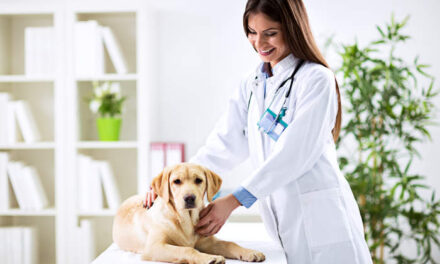If you’ve visited us here at the JPG before, you’ve probably noticed that a lot of our content is focused around puppy tips and advice to help puppy parents raise the happy and healthy dog they’ve always wanted.
As such, it may seem strange to you that we’re covering a topic here like hip and elbow dysplasia in dogs, which commonly leads to painful and debilitating joint diseases that can seriously affect your pet’s quality of life.
After all this only affects older dogs, right? Actually, WRONG!
Although joint dysplasia is less common in puppies and small breed dogs, it does happen. And besides, truth be told, if you’ve ever heard the famous saying by Benjamin Franklin …“An ounce of prevention is worth a pound of cure.”… it certainly holds true here. With that in mind, if you do have a puppy, difficult though it may be, take a break for a few minutes to read through this article and learn how to help your pup avoid years of pain. This is a big deal, especially if you have a large breed puppy.
What Exactly Is Dysplasia?
Dysplasia refers to the abnormal development of cells, organs, or structures from any of several causes. We’re going to address joint dysplasia within this article, which is when moving bones do not fit together right, resulting in permanent damage over time.
Although it can occur in almost any joint, dogs most often suffer from dysplasia of the hip and elbow. The condition is painful, progressive, disabling, and incurable, so all parents of new puppies need to know about it.
General Joint Structure
Joints are engineering miracles naturally designed to support weight and enable repetitive movement. Just as athletes have to balance muscle-building, for example, with rest to prevent damage, the same is true for your pup.
Dogs, especially large breeds, grow much faster than humans, so one of your jobs as a puppy parent is to control their exuberance so they don’t injure themselves as they run around and play. Something as simple as a flying leap off a couch can wrench the ligaments holding the bones together and put the whole skeletal framework out of alignment. To prevent locking up and erosion, joint surfaces are coated with shiny, smooth cartilage.
The entire joint is protected by a tough covering called the bursa, not unlike the airbags in your car, and filled with lubricating fluid that acts as a shock absorber. For a visual aid, examine the joints of a whole chicken, cooked or uncooked.
The hip joint consists of two bones, the pelvis and the femur (thigh bone) fitting together as a ball and socket. The elbow is more complicated, made up of three bones: the humerus (upper foreleg bone), the radius (in the human forearm, the bone that rotates over when you turn your palm upward and then back down), and the ulna (the bone that remains stable in your forearm when you turn your palm upward and then back down).

How Bones Grow
Many of us have grown up watching skeletons in cartoons as dry xylophones that talk and dance. In truth, bones are organized structures of living tissue always remodeling themselves. When subjected to lots of stress or fractures, the bone cells work like busy ants to reinforce areas that need fixing. That’s why exercise strengthens bones and areas of inactivity become thinner so that the minerals can be laid down elsewhere.
Since we’ve just mentioned cells, here’s a random fact. I bet you didn’t know that cells within your body largely get replaced every seven to ten years time! This slows down with age. Osteoarthritis is actually the body’s natural response to damage such as that caused by joint dysplasia. Although the bone itself is somewhat rebuilt, it’s at the cost of joint function. Cartilage can’t be repaired.
Returning to our chicken examination, you’ll begin to understand advanced arthritis by scraping away the cartilage and grinding the bare bone surfaces against each other. Then imagine the effect on functioning if the edges of one of the bones were cracking and splintering. All joint dysplasia causes osteoarthritis but elbow dysplasia additionally causes microfracturing. It’s the most common cause of front limb lameness in young large dogs, often causing a distinctive nodding of the head while walking.
Symptoms are often paradoxically worse after a long rest period as well as after a bout of exercise. The outcome of elbow dysplasia is often unpredictable regardless of treatment.While mobility impairment might be intermittent and mild for some dogs, others can suffer severe lifelong disability.
Who Gets Dysplasia?
Dogs of any size and breed can get joint dysplasia, but it’s most common in large breed dogs like Great Danes, Labradors, Golden Retrievers and German Shepherds just to name a few.
With shorter lifespans, the big dogs grow quickly, so any inherited tendency is quickly magnified. Vigorous joint-straining exercise during puppyhood, overabundant growth-stimulating nutrition, and obesity will worsen it.
Signs And Symptoms
Joint dysplasia can emerge as early as four months or hit in later years as other body changes take place. Watch out for the following:
-
- Changes in activity, energy levels, or body positioning
- Changes in range of motion (decreased movement)
- Changes in gait such as limping, head bobbing, waddling or hopping
- Changes in joints such as looseness or grating
- Changes in muscle symmetry of thighs or shoulder
- New onset of pain or stiffness, and swelling
How Is Dysplasia Diagnosed?
Share your observations with your vet so he or she can fine-tune the exam. Communicate your pup’s medical history including injuries and parents’ health. The vet may order blood tests as well as radiographs and other kinds of medical imaging to determine the degree of dysplasia.
Arthroscopy is a technique for diagnosis as well as treatment. Usually performed under general anesthesia, arthroscopy gives the vet a view like Captain Nemo could see from the Nautilus!
Can Dysplasia Be Prevented?
Picture a dog eager to go walking with you or attempting to play with other dogs but too crippled to keep up. If you’ve ever looked into the eyes of such a dog, you won’t forget it. Not all cases of dysplasia can be prevented, but there are steps you can take to reduce the risk. Prevention begins when your dog is very young. Maintain vet checks and communicate your concerns.
If you have a large breed provide the right diet specially formulated for large breed puppies. Be aware of the right balance of calcium and phosphorus, especially if preparing your own recipes. You don’t want to trigger excessive irreversible bone growth. Avoid table scraps and fatty foods no matter how charmingly your furbaby gazes up at you. Obesity affects multiple body functions so prevent it early while you still can.
Although joint supplements such as glucosamine and chondroitin are still being tested, many physicians and veterinarians recommend their use for early intervention and ongoing symptom reduction. So far they seem safe for long-term use.
Most of us are used to letting our pups have free romp time, but the truth is that uncontrolled exercise can result in injuries. Safe exercise practices are similar for humans and dogs: warm up first, avoid anything producing high impact, motions, choose resilient surfaces over hard surfaces, and don’t push your pup to extremes in anything. Just as shoes affect human posture, overgrown claws distort the way your dog supports its body weight. Without regular nail trims, puppies try to hold their feet in whatever position it takes to avoid discomfort and maintain balance.
The feet develop shortened tendons (tough connective tissue that connects muscles to bones) as others are stretched, so what was a temporary position eventually becomes set if not adjusted soon. Along these lines, many dog experts recommend harnesses rather than leashes to safely control your dog. Harnesses allow a more natural body posture with less chance of injury from sudden jerks.
Treatment Options
You’ll notice that many of the prevention measures also apply for treatment. They range from lifestyle modifications, all the way to surgery. We mentioned diet and supplements, weight control, and exercise adjustments.
Anti-inflammatory medications specifically for canines are helpful in pain management. Inflammation is a topic of growing interest to researchers because it affects so many body processes. Joint fluid modifiers are a promising new pharmacological method being tested.
Physical therapy has many proven benefits. Hydrotherapy (the pool!) and massage are popular. A newer modality called cold laser therapy done in the vet’s office is reported to provide significant relief to many animals by treating surfaces rather than deep tissues.
Providing a comfortable home environment avoiding temperature extremes – ask anyone with arthritis what a difference this makes!
Arthroscopy is a common surgical method to clean away fragments of loose cartilage and bone within a joint. It carries few risks and a quick recovery time. More advanced surgical interventions include partial joint modifications and total joint replacements, depending on the amount of cartilage and bone remaining.
Regenerative medicine is an exciting new field in molecular biology exploring tissue engineering to grow cells, tissues, and organs to restore natural function. Methods may include the use of stem cells and transfusions of altered plasma. Joint dysplasia is a lifelong condition but you can do a lot to make a difference in your puppy’s future.
Knowledge is power, they say, and now you’ve got the knowledge needed to make a difference for your pup! And your puppy will love you more for it.





